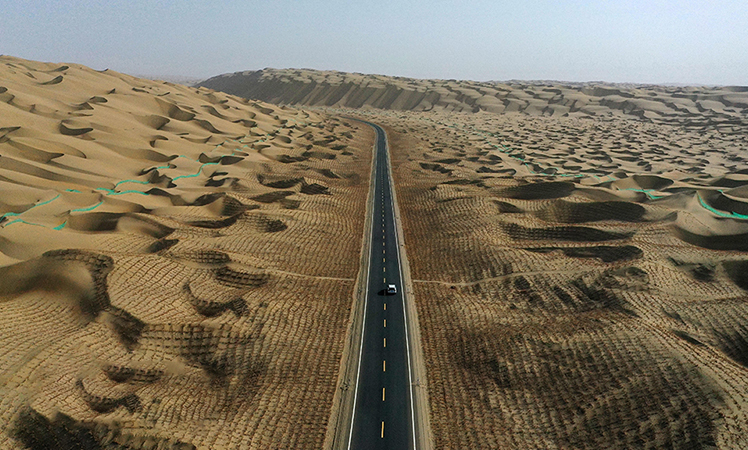China’s agri-tech industry abuzz as agricultural drones facilitate domestic proliferation of smart farming
Driven by a huge demand, the adoption of unmanned aerial vehicles or drones in agriculture for the protection of crops has been growing at a rapid pace in China in recent years, which has facilitated smart farming in the country.
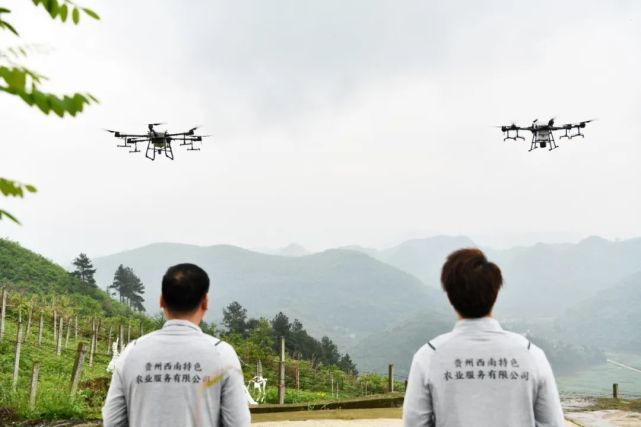
Drone pilots fly agricultural drones to perform tasks for cash crops in south China. (Xinhua/Yang Wenbin)
China had only about 4,000 crop protection drones in 2016, according to data from the country’s National Agro-Tech Extension and Service Center (NATESC). In 2021, more than 120,000 drones were used to spray pesticides on over 1.07 billion mu (about 71.33 million hectares) of farmland across the country, and there were over 200,000 agricultural drone pilots.
Cheng Guolin, a major grain grower who planted rice on 600 mu of paddy fields in Gannan county, Qiqihar city, northeast China’s Heilongjiang Province, was excited about the spraying efficiency of a drone in 2018 when the machine was used to spray pesticides for him for the first time.
In the past, he hired workers to wade through the fields to spray pesticides. “It took seven or eight people to manually spray pesticides on my farmland in two to three days, and over 10 liters of pesticides were used for each mu of land. But a drone could spray 100 mu of land in one hour, with less than 1 liter of pesticides for each mu of land,” said Cheng.
“The drone sprayed not only quicker but also much more evenly,” Cheng added. He bought an agricultural drone in 2019. Cheng’s agricultural drone has been used for spraying pesticides, sprinkling fertilizers and sowing seeds. He introduced that local crop growers mostly use drones to spray and replace manual work.
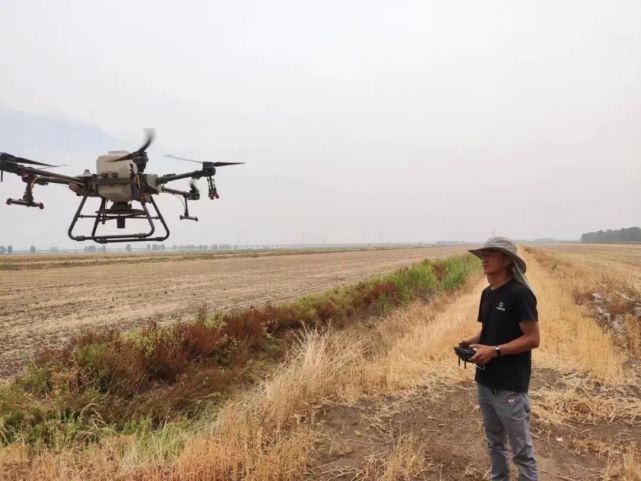
Wu Minggang, a Chinese agricultural drone pilot, operates a drone to spray pesticides. (Photo courtesy of the interviewee)
Wu Minggang, one of the first agricultural drone pilots in China, got into the industry in 2015. According to Wu, drones can reduce the risk of human exposure to toxic pesticides. But when he began to promote the application of agricultural drones in Heilongjiang, local farmers doubted their crop-dusting effects. To prove it, he had to visit farmers from door to door at first to show them for free how the drones were used to spray pesticides.
Two years later, agricultural drones were gradually accepted by farming households. The years 2017 and 2018 saw an explosive growth in these kinds of agricultural drones used for spraying fields. Now agricultural drones are no longer something new but a standard option for agricultural service providers and tech-savvy farmers.
In 2015, Heilongjiang had about 300 agricultural drones, which provided services for less than 1 million mu of farmland. Six years later, 17,000 drones in the province provided plant protection services for over 200 million mu of farmland. Besides, drones were used to sow seeds on over 100 million mu of land and sprinkle fertilizers over nearly 50 percent of paddy fields in the province in 2021.
Heilongjiang is just one of the many places in China that have used agricultural drones.
“China has become the country with the largest area of farmland served by agricultural drones in the world. Surveys for several consecutive years showed that a drone is 10 percent to 20 percent more efficient than the traditional way of spraying pesticides, and can reduce the use of pesticides by 20 percent to 30 percent while increasing the utilization rate of pesticides by more than 10 percent,” said Guo Yongwang, a researcher with the NATESC.
Guo introduced that breakthroughs have been made in the smart flight control system, spraying system, and payload capacity of drones, thanks to advances in science and technology. Drones have played an active role in reducing costs and increasing efficiency in agriculture, emergency rescue and disaster relief, and food security, while advancing agricultural modernization.
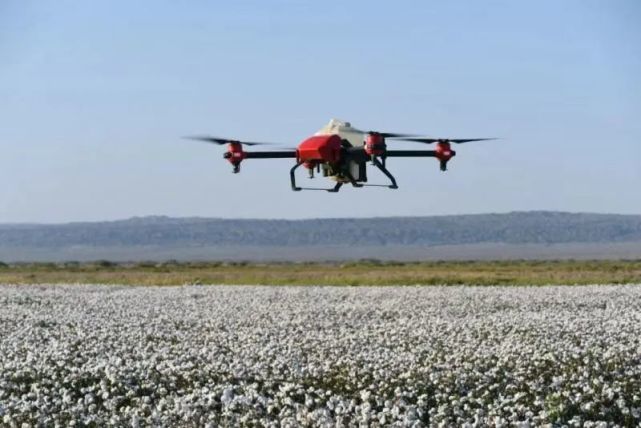
A drone flies over a stretch of farmland to spray pesticides. (Photo courtesy of the interviewee)
Leading Chinese drone makers such as XAG and DJI have speeded up the evolution of their technologies. In 2015, XAG’s agricultural drone product P20 and DJI’s MG-1 could complete operations on 50 mu of farmland within an hour. Last year, the two drone makers launched their new agricultural drone products, the P100 and T40, respectively, which can work on 320 mu of farmland per hour.
“In recent years, DJI has added image sensor technologies and obstacle-avoidance radar systems to its drones, enabling them to automatically bypass obstacles. We have also improved the flight control of our drones so that they can be efficiently used for irregular plots,” said Fan Wenze, director of DJI’s agricultural equipment department.
DJI’s rival XAG has also made innovations in recent years. Tong Wei, an executive of XAG, pointed out that the company’s latest agricultural drones can realize automatic farmland surveying, targeted spraying and intelligent seeding on various complex terrains.
Meanwhile, XAG’s upgraded drones have been crafted with a structure that can fully separate their flying platform from task systems. This means that they can switch flexibly between different functions. Transportation and maintenance of the company’s drones are also made much easier to increase operational efficiency. With a more advanced flight control system and operating system, the upgraded drones can remain steady and conduct efficient operations around farms even in those areas with a weaker Internet infrastructure.
“Drones make precision agriculture and digital agriculture possible,” said Cheng Zhongyi, who is responsible for DJI’s agricultural drone training.
Agricultural drones now have wider application scenarios. In addition to sowing seeds and sprinkling fertilizers, agricultural drones are also used to aid artificial pollination and can drop fodder.
By combining modern technologies such as the Internet of Things, big data and cloud computing, drones have been widely used in remote sensing, targeted plant protection, intelligent seeding, and other aspects, boosting the development of China’s smart agriculture, said Lan Yubin, director of the National Center for International Collaboration Research on Precision Agricultural Aviation Pesticide Spraying Technology.
“Globally, China is leading the rapid development of the drone industry,” said Wang Zhiguo, chairman of the National Aviation Plant Protection Science Technology Innovation Alliance.
China has led the world in flight control and ultra-low altitude pesticide spraying technologies of drones, Wang noted, adding that Chinese agricultural drones have been sold to over 20 countries and regions, including Europe, North America, Japan and Southeast Asia.
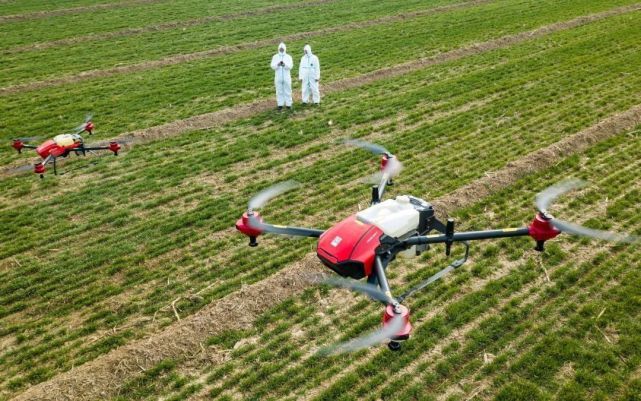
Drones fly over a stretch of farmland as they spray pesticides. (Photo courtesy of the interviewee)
In April 2019, China’s Ministry of Human Resource and Social Security and another two departments gave official recognition to 13 new professions, including drone pilots. The popularization of agricultural drones has created new jobs such as drone pilots and drone pilot instructors in rural areas and attracted more and more young people to go back to the countryside.
However, intense competition in the agricultural drone market is making drone pilots’ service fees plummet. According to Wu Minggang, an agricultural drone pilot could earn 1,000 yuan ($149.2) to 2,000 yuan or even several thousand yuan a day in 2017 and 2018. But this year, drone pilots’ service fees dropped to 2 yuan to 3 yuan per mu, said Chen Song, a drone pilot from northeast China’s Liaoning Province.
Since 2016, XAG has trained over 80,000 professional drone pilots. According to Tong, drone pilots need to provide more diverse and higher value-added services for farmers.
Pressing issues still exist, including cut-throat price competition, the variable quality of spraying pesticides, drone pilots’ lack of plant protection knowledge, and diminishing profitability. To ensure the sustainable development of China’s agricultural drone industry, all these issues should be promptly addressed.
In addition, to ensure the sound development of the agricultural drone industry, the highest priority is to strengthen supervision and improve regulation.
Photos
Related Stories
- Chinese university team sets drone flight time world record
- Wing Loong drones used in disaster relief, weather study
- Pentagon drones less cost-effective than prohibited Chinese craft: media
- Dazzling drone light show staged in Fuzhou
- Meituan unveils plans for drone delivery network
- China's medical firm uses drone to deliver biological samples
- Drone show held in Fuzhou to greet 4th Digital China Summit
- China unveils latest drone countermeasures at radar expo
- Drones deliver supplies to troops in drill
- Binhai New Area in Tianjin boosts development of drone industry
Copyright © 2022 People's Daily Online. All Rights Reserved.







